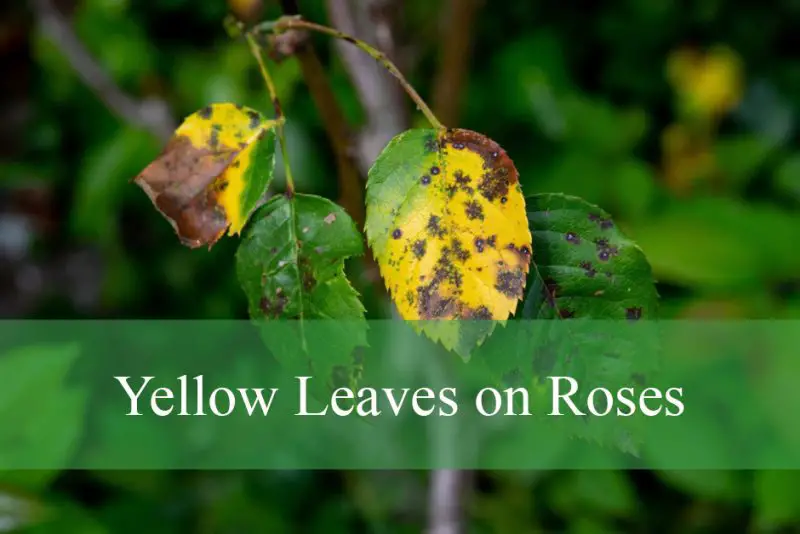Yellow leaves on roses are a common concern for gardeners who love to see their rose bushes thriving with lush green foliage and vibrant blooms. When the leaves begin to turn yellow, it often signals that something is wrong with the plant’s health. This issue not only affects the beauty of the roses but also weakens the overall growth, reducing flower production. Understanding why rose leaves turn yellow and finding effective solutions can restore the plant’s health and keep it blooming beautifully throughout the growing season.
The problem of yellow leaves on roses can be caused by several factors, ranging from environmental stress to nutritional deficiencies and diseases. Identifying the root cause early is essential to prevent further damage. Gardeners often worry that their rose bushes may die if the leaves continue to yellow and drop, but in most cases, timely intervention can reverse the problem. Healthy roses need balanced care, and knowing how to address yellowing leaves is an important part of rose maintenance.
In this guide, we will explore the most common reasons behind yellow leaves on roses and provide practical solutions to restore your plant’s health. By understanding the needs of your roses and responding to early warning signs, you can keep them strong, disease-free, and full of gorgeous blossoms.
Nutritional Deficiencies and Yellowing Leaves

One of the most frequent causes of yellow leaves on roses is nutrient deficiency. Roses are heavy feeders and require essential nutrients like nitrogen, iron, and magnesium to maintain healthy green foliage. A lack of nitrogen often leads to general yellowing, especially in older leaves. Nitrogen is responsible for leaf development and overall plant vigor, so when roses are deprived of it, they appear weak and pale. Gardeners who do not fertilize regularly or who use poor-quality soil often see this symptom in their rose bushes.
Iron deficiency, also known as iron chlorosis, is another major cause of yellowing. This condition typically affects new leaves first, which turn yellow while the veins remain green. It is more common in alkaline or compacted soils where iron is present but unavailable to the plant. Magnesium deficiency, on the other hand, causes yellowing that starts from the edges of older leaves and moves inward. Both deficiencies can severely reduce the plant’s ability to photosynthesize, making the rose bush less vigorous and more prone to disease.
Correcting nutrient deficiencies involves using a well-balanced rose fertilizer rich in essential micronutrients. Applying organic compost or manure improves soil fertility, while adjusting soil pH can make nutrients more available to the plant. For iron chlorosis, chelated iron or foliar sprays provide a quick fix, whereas magnesium deficiencies respond well to Epsom salt applications. Consistent feeding throughout the growing season ensures roses have the nutrients they need to stay healthy and green.
Water Stress and Poor Drainage
Improper watering practices are another leading cause of yellow leaves on roses. Both overwatering and underwatering stress the plant, causing its leaves to yellow and eventually drop. Roses need consistent moisture, but their roots dislike sitting in waterlogged soil. Overwatering leads to root rot, reducing the plant’s ability to absorb oxygen and nutrients. The first visible symptom of root stress is often yellowing foliage, followed by leaf drop and stunted growth.
Underwatering also contributes to yellow leaves, particularly during hot weather. Roses require deep watering to encourage strong root systems, but when they are left dry for long periods, the leaves start turning yellow, crisp, and brittle. This is the plant’s natural response to conserve water by shedding foliage. Gardeners who rely on light surface watering rather than deep soaking often face this problem.
Improving watering habits is crucial for preventing yellow leaves. Roses should be watered deeply at the base early in the morning, allowing the soil to dry slightly between waterings. Good drainage is equally important, as compacted or clay-heavy soils retain too much moisture, suffocating the roots. Amending the soil with organic matter and mulching helps retain moisture in dry conditions while improving drainage in heavy soils, giving roses the ideal environment for healthy root growth.
Pests and Their Impact on Rose Leaves
Pests are another common reason for yellow leaves on roses. Sap-sucking insects such as aphids, spider mites, and whiteflies feed on the plant’s juices, causing damage to the leaves and weakening the plant. Aphids cluster on young shoots and buds, sucking nutrients and leaving behind a sticky honeydew that attracts sooty mold. As they feed, the leaves curl, turn yellow, and eventually drop.
Spider mites are even more destructive, particularly in hot and dry weather. These tiny pests pierce leaf tissues, leaving behind stippled yellow spots that merge into larger patches. Severe infestations cause leaves to yellow completely and fall prematurely. Whiteflies, though less common on roses, also suck sap and cause similar yellowing symptoms. Infested plants often appear dull and lack vigor due to nutrient loss.
Controlling pests requires early detection and intervention. Regularly inspecting the undersides of leaves helps catch infestations before they spread. Spraying with insecticidal soap or neem oil effectively removes aphids and mites without harming beneficial insects. Encouraging natural predators such as ladybugs and lacewings also helps keep pest populations under control. Maintaining overall plant health through proper nutrition and watering makes roses less susceptible to pest attacks.
Fungal Diseases Causing Yellow Leaves
Fungal infections are another major contributor to yellow leaves on roses. Black spot, one of the most common rose diseases, often starts with small black lesions on the leaves, which eventually turn yellow and drop. Warm, humid conditions favor the spread of this fungus, and once it infects the plant, it can quickly defoliate the rose bush if left untreated.
Powdery mildew, although more recognized by its white powdery coating on leaves, can also lead to yellowing as the disease progresses. Infected leaves often curl and distort before turning yellow and falling. Rust is another fungal issue that causes orange or rust-colored spots on the undersides of leaves, which later lead to yellow patches and defoliation. All these fungal diseases weaken the plant and reduce flowering significantly.
Preventing fungal diseases involves maintaining good air circulation around rose bushes, watering at the base to keep foliage dry, and removing infected leaves promptly. Fungicidal sprays, either chemical or organic, help control existing infections. Regular pruning to thin dense growth improves airflow and reduces humidity, making the environment less favorable for fungal development. Healthy, well-nourished roses are naturally more resistant to disease, emphasizing the importance of consistent care.
Environmental Stress and Seasonal Changes
Sometimes, yellow leaves on roses are simply a response to environmental stress or natural seasonal changes. Extreme heat, sudden cold snaps, or strong winds can shock the plant, causing temporary leaf yellowing. Roses also naturally shed older leaves, especially at the bottom of the plant, as part of their growth cycle. In this case, the yellowing is not a sign of disease or nutrient deficiency but a normal process of renewal.
Transplanting roses or moving them to a new location can also trigger stress-related yellowing. The plant diverts energy to establish roots, temporarily sacrificing some foliage. Similarly, roses that are pruned heavily may drop some leaves as they adjust to the new growth pattern. These temporary stress responses typically resolve on their own as the plant adapts to its environment.
Minimizing environmental stress involves protecting roses from harsh weather whenever possible. Mulching around the base helps regulate soil temperature and moisture, while windbreaks or shade cloth can protect against extreme heat or drying winds. Gardeners should also avoid unnecessary disturbances during peak growing seasons to allow the plant to focus on healthy leaf and flower production.
Best Practices to Keep Roses Healthy and Green
Restoring a rose bush with yellow leaves requires a combination of proper nutrition, good watering practices, pest control, and disease prevention. A well-maintained rose is naturally more resistant to problems and can recover quickly from minor stress. Regular feeding with a balanced rose fertilizer ensures that the plant receives all the essential nutrients it needs to produce strong, green foliage.
Consistent watering is equally important. Deep, infrequent watering promotes deep root growth, which helps the plant withstand heat and drought. Mulching retains soil moisture, keeps roots cool, and prevents weeds that compete for nutrients. Pruning should be done carefully to remove dead or diseased wood while maintaining good airflow. Healthy pruning encourages vigorous growth and prevents fungal infections that often cause yellowing.
Monitoring the plant regularly is crucial for early detection of problems. Inspecting the leaves for pests, spotting the first signs of fungal diseases, and adjusting care based on seasonal changes help keep roses in top condition. When yellow leaves appear, acting quickly to determine the cause and applying the correct solution ensures that the plant recovers faster and continues to produce beautiful blooms.
FAQs about Yellow Leaves on Roses
Why are the leaves on my roses turning yellow?
Yellow leaves on roses can be caused by nutrient deficiencies, improper watering, pest infestations, fungal diseases, or environmental stress. Identifying the root cause early is essential to fix the issue and restore healthy growth.
Can overwatering cause yellow leaves on roses?
Yes, overwatering is a common reason for yellow leaves. Excess water suffocates the roots, leading to poor nutrient absorption and root rot, which causes foliage to yellow and drop.
What nutrient deficiency causes yellow leaves on roses?
Nitrogen, iron, and magnesium deficiencies are the most common nutrient-related causes. Nitrogen deficiency leads to overall pale leaves, while iron and magnesium deficiencies cause distinct yellowing patterns.
How do I treat yellow leaves caused by fungal diseases?
Treat fungal diseases by removing infected leaves, improving air circulation, and applying fungicidal sprays. Watering at the base and keeping foliage dry also help prevent future infections.
Will yellow leaves on roses turn green again?
Most yellow leaves will not turn green again, but new healthy growth will appear once the underlying problem is corrected. Pruning damaged foliage encourages fresh, vigorous leaves.
Conclusion
Yellow leaves on roses are a clear sign that the plant is under some form of stress, whether from nutrient deficiencies, improper watering, pests, diseases, or environmental changes. While the sight of yellowing foliage can be alarming, most issues can be corrected with proper care. Understanding the root cause and responding promptly is the key to keeping roses healthy and blooming.
By providing balanced nutrition, maintaining good watering habits, controlling pests and diseases, and minimizing environmental stress, gardeners can enjoy lush green foliage and abundant flowers throughout the growing season. Healthy roses are not only more beautiful but also more resilient, rewarding gardeners with long-lasting blooms and strong, vibrant growth.






